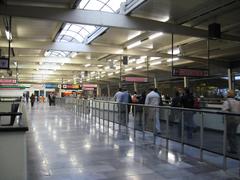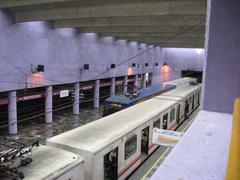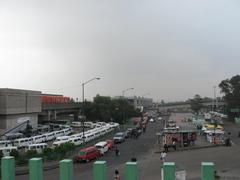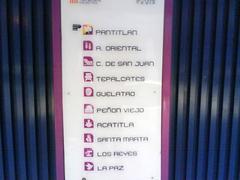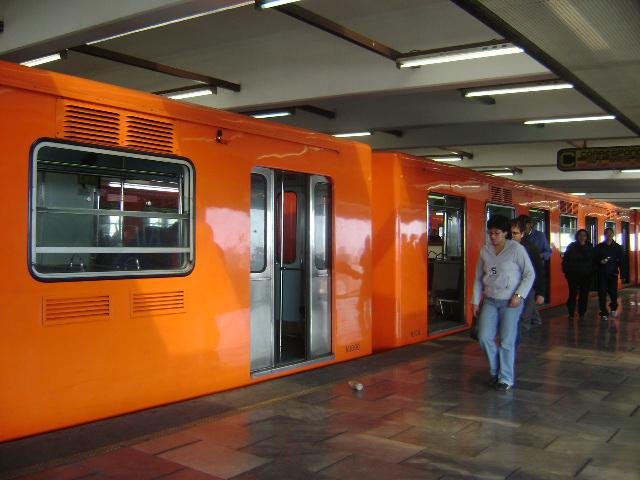
Pantitlán Mexico City: Visiting Hours, Tickets, and Historical Significance Guide
Date: 14/06/2025
Introduction
Pantitlán, located in the eastern borough of Iztacalco, is one of Mexico City’s most significant urban sites. Renowned as the only four-line interchange in the Mexico City Metro, Pantitlán functions as a crucial transportation node and a living testament to the city’s layered history. From its origins as a lakeside warning post in the Aztec era to its present-day role as a bustling urban hub, Pantitlán encapsulates the dynamic evolution of Mexico City. This guide provides a comprehensive overview of Pantitlán’s historical roots, practical visitor information, cultural and socioeconomic context, and travel tips to enrich your experience in this distinctive urban landscape (Wikipedia; Springer; Mexico News Daily; Metro CDMX; Britannica).
Table of Contents
- Historical Overview
- Visitor Information
- Cultural and Socioeconomic Significance
- Nearby Attractions
- FAQs
- Conclusion & Final Tips
- Call to Action
- Sources
Historical Overview
Pre-Hispanic and Aztec Era
Pantitlán’s name originates from the Nahuatl words meaning “between flags.” In the Aztec era, this area was a lakeside site on Lake Texcoco, where flagpoles warned canoeists of dangerous currents. The region was integral to the Mexica’s sophisticated water management system, with dikes, canals, and causeways supporting Tenochtitlan’s survival and prosperity (Wikipedia; Springer). Pantitlán was also associated with the worship of Tláloc, the rain god, reflecting the spiritual relationship between the people and their environment.
Colonial Transformation
With the arrival of the Spanish in the 16th century, Pantitlán underwent profound changes. The Spanish initiated large-scale drainage projects to reclaim land and prevent flooding, dramatically altering the landscape and erasing much of the original aquatic environment (Springer). These changes integrated Pantitlán into the growing city, setting the stage for further urban development.
Urbanization in the 20th Century
During the 20th century, Pantitlán transitioned from a rural fringe to a densely populated urban neighborhood. Residential and industrial sectors flourished, and the area became increasingly vital due to its proximity to the airport and major city venues (Mexico News Daily). Key infrastructure, such as Avenida Miguel Lebrija and Avenida Río Churubusco, enhanced its connectivity.
The Metro Era
The inauguration of Pantitlán Metro Station marked a turning point. First opened in 1981 (Line 5), with subsequent additions of Lines 1, 9, and A, Pantitlán became the only station in the network serving four lines (Wikipedia). The station’s design accommodates high passenger volumes with underground, at-grade, and elevated platforms. Its logo—two bare flagpoles—honors its Aztec origins.
Visitor Information
Metro Station Hours
Pantitlán Metro Station operates daily from 5:00 AM to midnight (Metro CDMX). These extended hours accommodate both commuters and tourists.
Ticket Prices and Access
- Single Ride: 5 Mexican Pesos (approx. $0.25 USD)
- Purchase Points: Tickets and rechargeable Metro Cards (Tarjeta Metro) are available at station booths and vending machines.
- Metro Cards: Recommended for convenience and reduced wait times.
Accessibility
The station is equipped with ramps, elevators, and tactile paving. While infrastructure supports passengers with disabilities, Pantitlán’s complexity and crowds may require additional assistance; staff members are available to help.
Travel Tips
- Avoid Rush Hours: Peak times are 7:00–9:00 AM and 6:00–8:00 PM.
- Security: Keep valuables secured and use crossbody bags.
- Women Travelers: Use women-only metro cars during busy periods.
- Official Taxis: Use authorized taxi stands or ride-hailing apps (Uber, Didi, Cabify) for safety, especially after dark.
- Stay Alert: Decline unsolicited help and avoid unofficial ticket sellers.
Cultural and Socioeconomic Significance
Pantitlán mirrors the diversity and resilience of Mexico City’s working-class communities. The neighborhood’s vibrant street life is evident in its markets, food stalls, and local events (Britannica). While urban renewal brings new amenities and infrastructure, residents continue to uphold traditions and community ties. The area faces typical urban challenges, including gentrification pressures and the need for improved public services (IR Review).
Nearby Attractions
- Mexico City International Airport: Accessible via short taxi or bus ride.
- Palacio de los Deportes & Foro Sol: Major venues for sports and concerts.
- Mercado Tlacotal: Traditional market offering local cuisine and crafts.
- Pantitlán Park: Green space for relaxation.
- Centro Histórico: Reachable on Line 1, home to the Zócalo, Metropolitan Cathedral, and Templo Mayor.
FAQs
Q: What are Pantitlán Metro station hours?
A: 5:00 AM to midnight daily.
Q: How much is a metro ticket?
A: 5 MXN per ride; rechargeable Metro Cards are available.
Q: Is Pantitlán accessible for people with disabilities?
A: Yes, with elevators and ramps, but expect crowds during peak hours.
Q: Are guided tours available?
A: While Pantitlán is primarily a transit hub, local agencies offer tours of nearby districts and markets.
Q: What attractions are near Pantitlán?
A: Mexico City International Airport, Palacio de los Deportes, Foro Sol, Mercado Tlacotal, and Pantitlán Park.
Conclusion & Final Tips
Pantitlán is not just a metro interchange—it is a reflection of Mexico City’s transformation from ancient lakefront settlement to a modern metropolis. Its historical roots and cultural vibrancy make it an ideal starting point for exploring the city. By following safety tips, planning around crowded times, and utilizing official transit resources, visitors can enjoy smooth access to both Pantitlán and the broader attractions of Mexico City. Downloading the Audiala app ensures up-to-date transit information and travel tips for a seamless experience (Wikipedia; Metro CDMX).
Call to Action
Explore more of Mexico City’s history and culture by reading our related articles and downloading the Audiala app for real-time updates, personalized guides, and exclusive tips. Share your Pantitlán experiences with us on social media and stay informed for your next adventure in Mexico’s vibrant capital.
Sources
- Pantitlán metro station, Wikipedia
- Water Management and Urbanism in Mexico City, Springer
- Mexico City’s Most Promising Neighborhoods in 2025, Mexico News Daily
- Mexico City Cultural Life, Britannica
- Official Mexico City Metro Website, Metro CDMX
- Mexico City Tourism, Visit Mexico
- The Gentrification of Mexico City, IR Review
- Mexico City Safety, Mexico Travel Secrets
- Mexico City Travel Tips, Mexico Travel Secrets
- Travel Safe Abroad: Mexico City Safety
- U.S. State Department Travel Advisory

